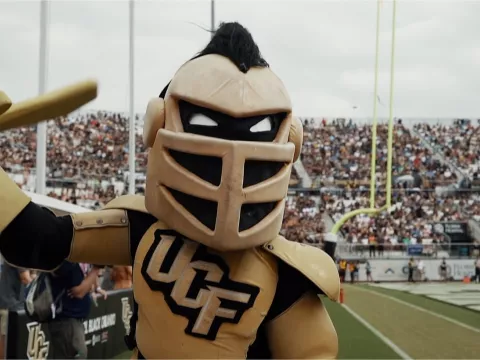- AdventHealth

The University of Central Florida’s football team doesn’t need a game coming up on Saturday to give them a sense of urgency about fine-tuning their performance.
Even in the offseason, each day is a valuable opportunity to help each athlete reach peak physical potential, remain academically eligible and stay as injury-free as possible. Meanwhile, athletic trainers are often the first to spot an athlete’s emotional or mental health struggles.
“Nobody spends more time with the athletes in the offseason than the strength room, and training room.” Says Burnside. We often catch something and can provide multiple layers for support for athletes who need assistance.
Aside from two brief periods of respite, the eight months of offseason are a nearly constant flurry of activity on teams across the country, says John Burnside, ATC, manager of sports partnerships at AdventHealth Sports Med and Rehab. We are the official hospital and preferred sports medicine and rehabilitation provider for UCF athletics.
Athletic trainers like Burnside are at the center of this complicated organization. They’re like the athletes’ quarterback, helping them maximize their physical, emotional and mental well-being.
A good support team in the offseason consists of not only the athletic trainers and doctors, but the physical therapist, registered dietician, mental health, and the performance team. Everyone needs to be on the same page to get complete buy-in from the athletes and coaches.
Burnside walks us through the rhythm of offseason life, starting at the beginning.
The Offseason Begins
For the UCF Knights, this year’s offseason began immediately after New Year’s Day, when they played in the Fiesta Bowl.
You might expect the players to be given a few months off, but that’s not the case, Burnside says. They typically get a couple weeks to clear their head and de-stress before returning to the weight room.
Often, this downtime provides the ideal opportunity for a player with a lingering health problem to get it taken care of. Perhaps they were playing with a lingering injury that needs to be taken care of, and now is the time to do so. To maximize the amount of recovery an athlete can get before the next season starts, the medical team will evaluate and create a plan for each athlete who is dealing with an injury.
That means every day is must be optimized.
“If I don’t get a player who needs an MRI into one, I’m wasting a day that could make a difference in getting this player closer to going back to the field,” he says. Rapid Diagnosis and treatment are benchmarks of a good sports medicine team, regardless of the time of year.
Time that athletes lose in the weight room and conditioning can be difficult to make up. The group does not wait for the injured guys to catch up when they start working out, so the athletic training staff must work closely with the strength and conditioning staff to ensure a safe return to participation for athletes recovering from injury.
“A good athletic trainer knows when to not push an athlete and pull back to prevent further injury”. Says Burnside. It is truly and art form at times and it starts with knowing your athletes and using great communication.
As often, it’s the player pushing themselves and the athletic trainer trying to hold them back.
“If you try to do too much, too soon, you could always do more damage,” he says
Getting the Right Calories
Whether they’re recovering or not, all athletes stay focused on nutrition during the offseason.
Starting in 2014, the NCAA allowed colleges to provide unlimited meals for players. Some schools now regularly spend millions of dollars a year per athlete on meals.
With college football players, you need to emphasize time management in getting proper nutrition. To often players are rushed to meetings and class after a workout or practice and lack enough time to replenish the body properly. The nutrition staff has a big role in making sure the players are getting what they need.
“You want to ensure the players get enough calories and the right calories,” he says. Their busy schedule can make this hard, so schools have learned to adapt.
They may eat at a “training table,” where athletes can take food or supplements to go. Some programs have a registered dietician who plates a specific player’s food to ensure they get the calories to meet their nutrition goals.
Eating right is crucial to building muscles, so it’s important a player has the fuel to repair and rebuild the muscle broken down in a workout. If a player has a morning workout followed by an early class, the nutrition staff may give the athlete a box of food to eat on the run.
“It’s important for them not to go into the red zone if they finished lifting and had to head to class before eating,” Burnside says.
One goal of this early offseason is to get them ready for spring football, which starts sooner than you might think.
Back to Football Mode
From January to March, the team’s time is solely focused on getting bigger, faster, and stronger, and for those recovering from injury, it means getting healthy.
As spring football approaches, football typically shifts into a more intense conditioning cycle that is led by the coaches. Most athletic trainers are on high alert at this time and protecting certain athletes from participating in drills that might be detrimental.
All this work will pay off months later, when the season begins, with “more player buy-in and fewer missed days,” he says.
“Once spring football is over, the players get another brief period of rest and recharge prior to the final grind leading up to the season. Once summer conditioning starts in May, the players will not get another break until January” Burnside says.
Through it all, athletic trainers are the point person for an athlete’s mental and emotional health, too. “We always need to be vigilant in watching for guys struggling both physically or mentally”.
The Mental Game
Because an athletic trainer is spending so much time with the athlete and developing a relationship, they’re often the first person to spot trouble.
“We are meeting with the athlete day-to-day, knowing when they’re stressed, when they’re overburdened with schoolwork or their personal life,” he said. The athletic trainer’s job here is to help direct the player to get mental health treatment if they need it and be an advocate for them.
“if a player is not focused because of stress either from school, home, or his social life that is distracting them from performing, we have a responsibility to intervene,” Burnside says. These are young adults, he adds, and it’s difficult for them to divide the 24 hours in each day among their personal, academic and athletic lives.
“We know enough to be able to recognize a mental health issue and point them in the right direction,” Burnside says.
Making Each Day Count
Admittedly, an athletic trainer’s day is most crowded during the season, when they can work for 90 or more hours a week, Burnside says. But the offseason is no break.
“It takes incredible coordination behind the scenes to get 120 or more athletes ready to play. “The amount of work that takes requires the full eight months and requires an entire support team.”
The same holistic care philosophy and goal-oriented, team approach we offer to UCF athletes also helps regular Floridians achieve whole-person health. To learn more about the services we offer, click here.


